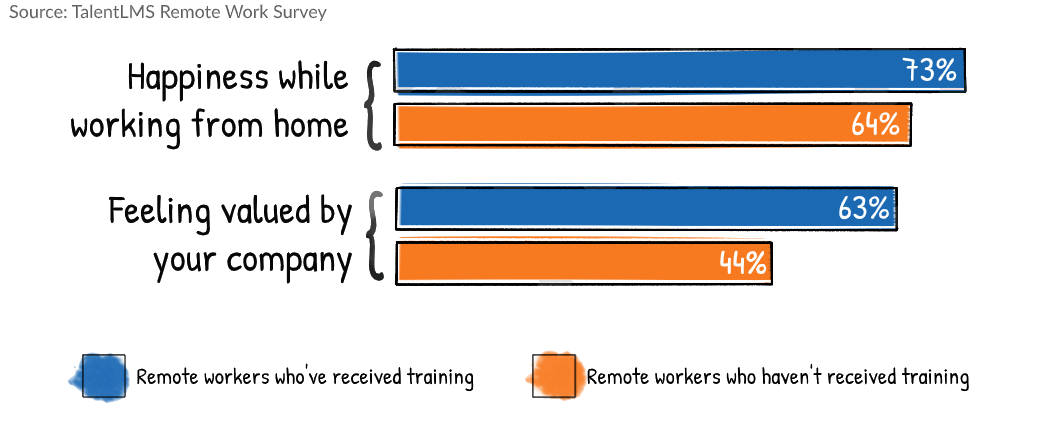The rise of remote work has made your employer brand more important than ever. People can now look for job opportunities anywhere in the world. If you want to attract and retain talent, you need to be competitive in the market. Good compensation plans and beautiful offices aren’t enough to convince people to stay with your company.
You have to offer the “whole package,” which means a workplace where people can thrive.
Building a reputation as a company that supports and invests in your people will help you stand out and increase employee retention. And that happens when you invest in employee development.
What employees want
People don’t view their jobs as just a means to a paycheck. More and more, they value a work-life balance and look for more purpose and fulfillment in their jobs.
Employees want the opportunity for career advancement and personal growth. And if they don’t feel those goals are supported in their current workplace, they’re likely to seek another.
In a recent survey of remote workers, 35% indicated they were considering leaving their employer in the next year. Those considering leaving overwhelmingly cited feeling undervalued at work and didn’t see room for professional growth if they stayed.
And companies aren’t always helping them see the road to advancement. In that same survey, 61% of remote employees say that additional training would help them perform better in their roles, whether they already receive training or not.
How employee development can help
Employee development can play a big role in alleviating those concerns. Remote employee training does more than just improve productivity. Employees who received training also feel more valued by their companies and report greater happiness in their jobs.
In that same survey, 9% of remote workers who receive training reported higher rates of happiness with their jobs than those who haven’t received training. And nearly 20% more reported feeling valued by the company.

And those numbers are quite significant when you consider how easy it is for employees nowadays to land a new job. With the rise of remote work, they have a greater variety of options, so they’re more likely to move to (and stay with) a company where they feel valued—and so do their coworkers.
Employee development is a key factor in employee retention and should be central to your employer branding strategy. But a successful development plan goes beyond just offering training.
Employee development is more than just training
Most people would probably agree that training is important for career health. And many companies now offer training. But there are lots of ways to interpret what “training” entails, and not all learning strategies are created equal.
If by “training”, you’re thinking of an onboarding session and access to an online library or tickets to an annual conference, don’t expect it to make an impact on your employer brand. You need to think of training as employee development, an investment in your people and your growth.
Knowing the different ways employee training can boost your brand will help you know what kind of training to offer and how and when to implement it.
Employee training: an employer brand booster
To increase employee retention and grow your company going forward, you need to be an attractive option to workers. Helping your employees feel valued and investing in their work experience and careers means putting careful thought into employee development.
Here are six ways you can use employee training to boost your employer brand:
1. Reskill and upskill
There’s training that’s mandatory—for example, when you train your new hires on company policies, when you deliver a course on cybersecurity, or when you give a company-wide presentation on workplace safety. And then there’s reskilling and upskilling.
This is the kind of training that helps people refresh and update their skill sets and sets them up for career success. When you invest in their skills, employees won’t feel compelled to change companies when they want to advance professionally or when their role becomes obsolete.
And a necessary reality check: Not every employee will advance their career within your organization. This doesn’t mean, though, you should skip out on offering reskilling/upskilling opportunities to all of your people. You may not be able to promote them, but they could transition to another department or keep their current role and take on new tasks or bring more creative ideas to the table using their recently acquired skills.
Some of your team members might still look elsewhere for their next career step. And that’s ok. Showing that you care about their futures by teaching them the skills they need in today’s workplace is good for your employer brand. Your alumni are the most reliable sources when someone wants to know what it looks like working at your company.
When you invest in their skills development, at least they’ll recognize the effort and put a good word out there—whether they stay in the long run or not. And at the most, you’ll have gained well-equipped team members. It’s a win-win in both cases.
2. Personalize learning
eLearning makes it easier than ever to roll out training to employees no matter where they are. Just-in-time and self-paced learning mean you can reach everyone and provide a consistent learning experience across the board. But one-size-fits-all programs often lack the specific knowledge and skills required for every position.
Consider creating personalized learning specifically tailored to a learner’s situation or connected to their career path. You can build different versions of courses for different roles and offer training specific to an employee’s job.
For example, a sales rep is going to need training on how to talk about and highlight the features of a new product. They should be able to explain how it solves clients’ problems or fits in their needs. A customer service rep, on the other hand, requires training that walks them through troubleshooting issues that come up with the product.
With online learning, you can offer different versions of the same training. In our example, both employees would get the same theoretical course on how a feature works. Then, depending on their role, they would have different assignments so they can learn either how to sell that feature or how to troubleshoot potential issues.
Use your LMS to recognize a learner’s role when they log in. You can populate their homepage with a custom menu highlighting relevant training for them.

Deliver tailor-made training with TalentLMS.
Create sub-accounts for different audiences, customize as needed,
and manage everything from one place.
3. Be proactive, not reactive with training
Don’t limit yourself to training employees only for the role they have now—waiting until they’re moved to a new role to help them upskill. Instead, consider proactively training them to prepare them for the future.
For example, leadership training isn’t just for those currently in leadership positions. Management skills benefit employees at every level in the company. And employees are much more comfortable moving into leadership roles when they’ve already been trained to handle them.
It’s hard for people to see a future with your company if you aren’t helping them prepare for it. Don’t leave your employees feeling stranded in their career goals by waiting to teach them important skills. You can start coaching them for what’s ahead from the day they join your team. When you offer training proactively, you communicate your investment in their future.
4. Deliver more than just job-related content
Your training should focus on content that would attract and retain employees. Employees aren’t just looking for the hard skills associated with their jobs. Yes, they need to know the ins and outs of how to succeed in the role. But consider expanding your offerings with content that improves people’s employee experience.
That could involve hard skills like project management training. But, soft skills training, or even training that goes beyond the workplace, could be perceived as a meaningful benefit. For example, teach communication skills to help people better manage their work relationships. Or, roll out content on how to deal with mental health issues or how to practice mindfulness to help reduce stress and anxiety.
When you help employees have a better all-around experience with their jobs, they’re more likely to stay with the company. And they’re going to be happier, and thus more productive, in their work.
Meet TalentLibrary™
A growing collection of ready-made courses
that your teams can access at any time, and at their own pace![]()

5. Provide interdisciplinary training
Interdisciplinary training is another form of non-job-related training that employees can benefit from. Help people understand not just their own jobs, but also the work that goes on around them. Understanding the connections can help them think more clearly about their own role and possibly invest more in it.
For example, developers already get training on new tech and new programming languages. But how about teaching them what happens once they’ve released a product? With sales and marketing training, they can better understand user requirements and how the business operates as a whole. And that can help them build better products in the future.
How does this help your employer brand? When people see the big picture, they feel more connected to the company. They understand their role and their contribution to the team’s success. Besides, learning from each other builds a greater sense of community—something that increases happiness at work.
6. Reinforce company culture and belonging
Training those who work offsite can significantly reduce the feelings of isolation that often hurt remote work satisfaction and productivity. When you offer regular training, you show employees that you value them and that you’re aware of them.
While self-paced learning is efficient for remote employees, consider also maintaining some live training sessions. Even if you’re doing them via video conferencing, the opportunity to interact with colleagues can help people feel more like they’re part of a team.
You can also enhance company culture with engaging training on things like company policies, culture, and soft skills. These can strengthen your brand by reminding people of your values and helping them see how you’re living them. They’ll also help people feel immersed in the culture, and thus more connected to the company.
Build your employer brand by living your values
Your people are your most valuable asset. Creating a brand that makes them want to stay is crucial to your growth in a largely remote workforce.
Having a good employer brand isn’t about promoting the fact that you develop your people and offer training opportunities. It’s about actually doing that. The more you cultivate a culture of continuous learning, the more you’ll improve your reputation as an employer. And the happier your employees will be to stay on and grow with you.
